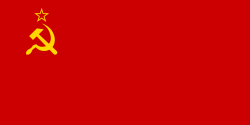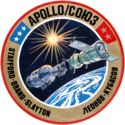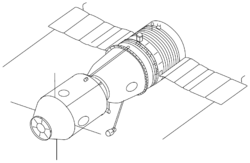Sojuz 20
| Sojuz 20 (Союз-20) | |||
| Modell | Sojuz 7K-T | ||
|---|---|---|---|
| Färdens tid | 90 dagar, 11 timmar, 46 minuter | ||
| Massa | 6 570 kg | ||
| NSSDC-ID | 1975-106A[1] | ||
| Uppskjutning | |||
| Startplats | Bajkonur LC1 | ||
| Start | 17 november 1975, 14:38:00 UTC | ||
| Raket | Sojuz | ||
| Landning | |||
| Landningsplats | 56 km SV om Arqalyq | ||
| Landning | 16 februari 1976, 02:24:00 UTC | ||
| Omloppsbana | |||
| Varv | 1 470 st | ||
| Apogeum | 251 km | ||
| Perigeum | 177 km | ||
| Banlutning | 51,6° | ||
| Besättning | |||
| Besättning | Obemannad | ||
| Dockning | |||
| Rymdstation | Saljut 4 | ||
| Kronologi | |||
| |||
Sojuz 20 (ryska: Союз-20) var en obemannad flygning i det sovjetiska rymdprogrammet. Farkosten sköts upp från Kosmodromen i Bajkonur med en Sojuz-raket, den 17 november 1975. Under större delen av flygningen var den dockad med rymdstationen Saljut 4. Farkosten återinträdde i jordens atmosfär och landade i Sovjetunionen den 16 februari 1976.
Källor och referenser
- ^ ”NASA Space Science Data Coordinated Archive” (på engelska). NASA. https://nssdc.gsfc.nasa.gov/nmc/spacecraft/display.action?id=1975-106A. Läst 28 februari 2020.
| |||||||||||||||||||||||||||||||||||||||||||||||||||||||||||||||||||||||||||||||||||||||||
| |||||||
Media som används på denna webbplats
Soyuz-TM spacecraft. Compare the antennas on the orbital module to those on Soyuz-T. Differences reflect the change from the Igla rendezvous system used on Soyuz-T to the Kurs rendezvous system used on Soyuz-TM.
Apollo-Soyuz Test Project (ASTP) Soyuz. The APAS-75 docking unit is located at left.
The Soyuz TMA-04M spacecraft is seen after being rolled out by train to the launch pad at the Baikonur Cosmodrome in Kazakhstan, May 13, 2012. The launch of the Soyuz spacecraft, with Expedition 31 Soyuz Commander Gennady Padalka, Flight Engineer Sergei Revin of Russia and NASA Flight Engineer Joe Acaba, is scheduled for 9:01 a.m., May 15 (Kazakhstan time).
This is the American crew insignia of the joint United States-USSR Apollo-Soyuz Test Project (ASTP). Of circular design, the insignia has a colorful border area, outlined in red, with the names of the five crew members and the words Apollo in English and Soyuz in Russian around an artist's concept of the Apollo and Soyuz spacecraft about to dock in Earth orbit. The bright sun and the blue and white Earth are in the background. The white stars on the blue background represent American astronauts Thomas P. Stafford, commander; Vance D. Brand, command module pilot; and Donald (Deke) K. Slayton, docking module pilot. The dark gold stars on the red background represent Soviet cosmonauts Aleksey A. Leonov, commander, and Valeriy N. Kubasov, engineer.
Salyut Program insignia.
Soyuz-A manned spacecraft concept (1963). It was to have been part of the Soyuz A-B-C circumlunar complex.












